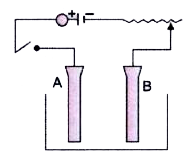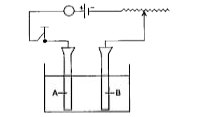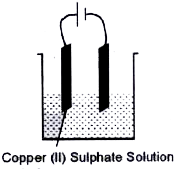Which electrode : anode or cathode is the oxidising electrode ? Why?
To determine which electrode, the anode or the cathode, is the oxidizing electrode, we can follow these steps:
1. Define the Electrodes:
- The anode is the positively charged electrode.
- The cathode is the negatively charged electrode.
2. Understand Charge Attraction:
- Anions (negatively charged ions) are attracted to the anode because opposite charges attract.
3. Identify the Reaction at the Anode:
- At the anode, anions will lose electrons as they are deposited on the electrode.
4. Define Oxidation:
- The process of losing electrons is known as oxidation.
5. Conclusion:
- Since oxidation occurs at the anode (where the loss of electrons takes place), the anode is identified as the oxidizing electrode.
Final Answer:
The oxidizing electrode is the anode because it is where oxidation occurs due to the loss of electrons.
---
- The anode is the positively charged electrode.
- The cathode is the negatively charged electrode.
- Anions (negatively charged ions) are attracted to the anode because opposite charges attract.
- At the anode, anions will lose electrons as they are deposited on the electrode.
- The process of losing electrons is known as oxidation.
- Since oxidation occurs at the anode (where the loss of electrons takes place), the anode is identified as the oxidizing electrode.
The oxidizing electrode is the anode because it is where oxidation occurs due to the loss of electrons.
Topper's Solved these Questions
Similar Questions
Copper sulphate soln. is electtrolysed using copper electrodes as seen in diagram .
Which electrode to your left or right is known as the oxidising electrode & why ?

View SolutionStudy the diagram given below and answer the question that follow

Which electrons is the oxidising electrode ?
View Solution
Knowledge Check
Study the given figure and answer the question that follow:

Which electrode is the oxidising electrode?AABBCBoth (a) and (b)DNone of theseCathode is a reducing electrode because:
AIt has less number of electronsBIt has deficiency of electronsCCations gain electrons from cathodeDAnions lose electrons to cathode
Copper sulphate solution is electrolysed using copper electrodes. Study the diagram given below and answer the question that follows: Which electrode to your left or right is known as the oxidising electrode and why?

View SolutionA: Anode is positive electrode and cathode is negative electrode in electrolytic cell.
R: Anode is negative electrode and cathode is positive electrode in galvanic cell.
View SolutionHere is an electrode reaction
Cu→Cu2++2e−
At which electrode (anode or cathode) would such a reaction take place ? Is this an example of oxidation or reduction.
View SolutionHere is an electrode reactin :
Cu→Cu2++2e
At which electrode (anode or cathode) would such a reaction take place ? Is this an example of oxidation or reduction ?
View SolutionGive reasons for the following - pertaining to Hall Herault's process.
It is preferred to use a number of graphite electrodes as anode, instead of a single graphite electrode.
View SolutionThe standard reduction potentials of magnesium and iron electrodes are -2.73 V and -0.44 V respectively. Which electrode will undergo oxidation and which electrode reduction ?
View Solution
